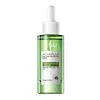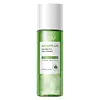What's inside
What's inside
 Key Ingredients
Key Ingredients

 Benefits
Benefits

 Concerns
Concerns

 Ingredients Side-by-side
Ingredients Side-by-side

Water
Skin ConditioningPropanediol
SolventHydroxyethyl Urea
HumectantButylene Glycol
HumectantPPG-24-Glycereth-24
EmulsifyingPhenoxyethanol
PreservativeAmmonium Polyacryloyldimethyl Taurate
Emulsion StabilisingGluconolactone
Skin ConditioningTriethanolamine
BufferingHydroxyacetophenone
AntioxidantPEG-40 Hydrogenated Castor Oil
EmulsifyingNiacinamide
SmoothingSclerotium Gum
Emulsion StabilisingAtractylodes Macrocephala Root Extract
Skin ConditioningAstragalus Membranaceus Root Extract
EmollientSaposhnikovia Divaricata Root Extract
AntimicrobialAlbizia Julibrissin Bark Extract
MaskingGlycyrrhiza Uralensis Extract
EmollientChamomilla Recutita Flower Extract
MaskingGlycerin
HumectantDisodium EDTA
Lactobionic Acid
BufferingCaprylic/Capric Triglyceride
Masking10-Hydroxydecanoic Acid
Skin ConditioningIsohexadecane
EmollientCeramide AP
Skin Conditioning1,2-Hexanediol
Skin ConditioningCedrus Atlantica Bark Oil
MaskingQuaternium-73
Pelargonium Graveolens Oil
MaskingZinc PCA
HumectantMelaleuca Alternifolia Leaf Oil
AntioxidantCitrus Paradisi Peel Oil
MaskingCocamidopropyl Dimethylamine
EmulsifyingSalicylic Acid
MaskingMadecassoside
AntioxidantAsiaticoside
AntioxidantAsiatic Acid
Skin ConditioningMadecassic Acid
Skin ConditioningEthylhexylglycerin
Skin ConditioningWater, Propanediol, Hydroxyethyl Urea, Butylene Glycol, PPG-24-Glycereth-24, Phenoxyethanol, Ammonium Polyacryloyldimethyl Taurate, Gluconolactone, Triethanolamine, Hydroxyacetophenone, PEG-40 Hydrogenated Castor Oil, Niacinamide, Sclerotium Gum, Atractylodes Macrocephala Root Extract, Astragalus Membranaceus Root Extract, Saposhnikovia Divaricata Root Extract, Albizia Julibrissin Bark Extract, Glycyrrhiza Uralensis Extract, Chamomilla Recutita Flower Extract, Glycerin, Disodium EDTA, Lactobionic Acid, Caprylic/Capric Triglyceride, 10-Hydroxydecanoic Acid, Isohexadecane, Ceramide AP, 1,2-Hexanediol, Cedrus Atlantica Bark Oil, Quaternium-73, Pelargonium Graveolens Oil, Zinc PCA, Melaleuca Alternifolia Leaf Oil, Citrus Paradisi Peel Oil, Cocamidopropyl Dimethylamine, Salicylic Acid, Madecassoside, Asiaticoside, Asiatic Acid, Madecassic Acid, Ethylhexylglycerin
Water
Skin ConditioningGlycerin
HumectantCellulose
AbsorbentSodium Chloride
MaskingSodium Citrate
BufferingButylene Glycol
HumectantPhenoxyethanol
PreservativeLactobionic Acid
BufferingCitric Acid
BufferingHydroxyacetophenone
AntioxidantPseudoalteromonas Ferment Extract
HumectantSodium Hyaluronate
HumectantPEG-40 Hydrogenated Castor Oil
EmulsifyingDisodium EDTA
Astragalus Membranaceus Root Extract
EmollientAminomethyl Propanol
BufferingSaposhnikovia Divaricata Root Extract
AntimicrobialCalendula Officinalis Flower Extract
MaskingCaprylic/Capric Triglyceride
MaskingIsohexadecane
EmollientSodium Salicylate
PreservativeGastrodia Elata Root Extract
Skin ConditioningAlbizia Julibrissin Flower Extract
Skin ConditioningHamamelis Virginiana Extract
AntiseborrhoeicCedrus Atlantica Bark Oil
MaskingMelaleuca Alternifolia Leaf Oil
AntioxidantCitrus Paradisi Peel Oil
MaskingPelargonium Graveolens Oil
MaskingGlycolic Acid
BufferingQuaternium-73
1,2-Hexanediol
Skin ConditioningMadecassoside
AntioxidantAsiaticoside
AntioxidantAsiatic Acid
Skin ConditioningMadecassic Acid
Skin ConditioningWater, Glycerin, Cellulose, Sodium Chloride, Sodium Citrate, Butylene Glycol, Phenoxyethanol, Lactobionic Acid, Citric Acid, Hydroxyacetophenone, Pseudoalteromonas Ferment Extract, Sodium Hyaluronate, PEG-40 Hydrogenated Castor Oil, Disodium EDTA, Astragalus Membranaceus Root Extract, Aminomethyl Propanol, Saposhnikovia Divaricata Root Extract, Calendula Officinalis Flower Extract, Caprylic/Capric Triglyceride, Isohexadecane, Sodium Salicylate, Gastrodia Elata Root Extract, Albizia Julibrissin Flower Extract, Hamamelis Virginiana Extract, Cedrus Atlantica Bark Oil, Melaleuca Alternifolia Leaf Oil, Citrus Paradisi Peel Oil, Pelargonium Graveolens Oil, Glycolic Acid, Quaternium-73, 1,2-Hexanediol, Madecassoside, Asiaticoside, Asiatic Acid, Madecassic Acid
 Reviews
Reviews

Ingredients Explained
These ingredients are found in both products.
Ingredients higher up in an ingredient list are typically present in a larger amount.
1,2-Hexanediol is a synthetic liquid and another multi-functional powerhouse.
It is a:
- Humectant, drawing moisture into the skin
- Emollient, helping to soften skin
- Solvent, dispersing and stabilizing formulas
- Preservative booster, enhancing the antimicrobial activity of other preservatives
Asiatic Acid is a major component of Centella Asiatica Extract. It has wound-healing, anti-inflammatory, and antioxidant properties.
Studies show Asiatic Acid is able to block the pathway for skin inflammation receptors, helping to soothe skin.
As an antioxidant, asiatic acid helps protect our skin against damaging environmental factors.
Learn more about Asiatic AcidAsiaticoside comes from the super popular skin-soothing ingredient, Centella asiatica. It is one of four active compounds found in the extract of Centella Asiatica.
Asiaticoside is an antioxidant and helps with wound healing. It has been shown to increase antioxidant activity during the wound healing process.
Astragalus Membranaceus Root Extract is from an herb called Huang Qi. The roots of this plant have traditionally used in traditional Chinese medicine.
Butylene Glycol (or BG) is used within cosmetic products for a few different reasons:
Overall, Butylene Glycol is a safe and well-rounded ingredient that works well with other ingredients.
Though this ingredient works well with most skin types, some people with sensitive skin may experience a reaction such as allergic rashes, closed comedones, or itchiness.
Learn more about Butylene GlycolThis ingredient is an emollient, solvent, and texture enhancer. It is considered a skin-softener by helping the skin prevent moisture loss.
It helps thicken a product's formula and makes it easier to spread by dissolving clumping compounds.
Caprylic Triglyceride is made by combining glycerin with coconut oil, forming a clear liquid.
While there is an assumption Caprylic Triglyceride can clog pores due to it being derived from coconut oil, there is no research supporting this.
Learn more about Caprylic/Capric TriglycerideThis ingredient comes from the bark of the Cedarwood tree.
Though this oil exhibits antibacterial and antioxidant activity, it is also contains skin-irritating fragrances such as limonene.
In 2023, it was listed as an EU known-allergen.
Learn more about Cedrus Atlantica Bark OilCitrus Paradisi Peel Oil is the volatile oil expressed from the peel of the Grapefruit, Citrus paradisi, Rutaceae.
The term 'fragrance' is not regulated in many countries. In many cases, it is up to the brand to define this term. For instance, many brands choose to label themselves as "fragrance-free" because they are not using synthetic fragrances. However, their products may still contain ingredients such as essential oils that are considered a fragrance.
Disodium EDTA plays a role in making products more stable by aiding other preservatives.
It is a chelating agent, meaning it neutralizes metal ions that may be found in a product.
Disodium EDTA is a salt of edetic acid and is found to be safe in cosmetic ingredients.
Learn more about Disodium EDTAGlycerin is already naturally found in your skin. It helps moisturize and protect your skin.
A study from 2016 found glycerin to be more effective as a humectant than AHAs and hyaluronic acid.
As a humectant, it helps the skin stay hydrated by pulling moisture to your skin. The low molecular weight of glycerin allows it to pull moisture into the deeper layers of your skin.
Hydrated skin improves your skin barrier; Your skin barrier helps protect against irritants and bacteria.
Glycerin has also been found to have antimicrobial and antiviral properties. Due to these properties, glycerin is often used in wound and burn treatments.
In cosmetics, glycerin is usually derived from plants such as soybean or palm. However, it can also be sourced from animals, such as tallow or animal fat.
This ingredient is organic, colorless, odorless, and non-toxic.
Glycerin is the name for this ingredient in American English. British English uses Glycerol/Glycerine.
Learn more about GlycerinHydroxyacetophenone is antioxidant with skin conditioning and soothing properties. It also boosts the efficiency of preservatives.
This ingredient is not irritating or sensitizing.
Isohexadecane is added to enhance texture, emulsify, and to help cleanse. It is an isoparrafin. It is a component of petrolatum.
Due to its large size, Isohexadecane is not absorbed by the skin. Instead, it sits on top and acts as an emollient. Emollients help keep your skin soft and smooth by trapping moisture within.
Isohexadecane is often used in products designed to help oily skin. It is lightweight and non-greasy while helping to moisturize. When mixed with silicones, it gives a product a silky feel.
Learn more about IsohexadecaneLactobionic Acid is a PHA. PHAs are the gentle cousins to AHAS.
Like AHAs, they exfoliate the top layer of skin. Lactobionic acid also exhibits significant antioxidant activity.
PHAs are more gentle than AHAs due to their larger structure. This means they do not penetrate as deeply as AHAs and take a longer time to dissolve dead cells. Studies show PHAs do not cause as much irritation.
By removing dead skin cells, PHAs leave the skin brighter and with even-texture.
Learn more about Lactobionic AcidMadecassic Acid is a major component of Centella Asiatica Extract. It has anti-inflammatory and antioxidant properties.
It is a triterpenoid, meaning it naturally acts as an antioxidant. Antioxidants protect your skin against damage from environmental factors such as pollution and UV.
Studies show Madecassic Acid helps soothe the skin due to its ability to block inflammation pathways.
Learn more about Madecassic AcidMadecassoside comes from the super popular skin-soothing ingredient, Centella asiatica. It is one of four active compounds found in the extract of Centella Asiatica.
Madecassoside has antioxidant, anti-inflammatory, and hydrating properties. It contains fatty acids, amino acids, beta-carotene, and phytochemicals.
One study found using Madecassoside with ascorbic acid helped reduce the signs of aging and improved skin hydration.
Learn more about MadecassosideThis tea tree oil comes from the leaves of the Tea Tree plant. Tea tree oil has antioxidant, anti-inflammatory, and antimicrobial properties.
According to the book Journal of Profiles of Drug Substances, tea tree helps in reducing acne-causing bacteria such as Propionibacterium acnes. This is due to the Terpinen components of tea tree oil.
Tea tree may cause sensitivity and irritation for some people. This oil naturally contains fragrance such as linalool and limonene.
However, research shows irritation usually occurs when using pure tea tree oil and not in cosmetic products.
Tea tree oil was found to help relieve the symptoms of psoriasis in one study.
Tea tree oil is toxic when ingested. Another study showed it to caused damage to the nervous system of dogs and cats when applied to their skin or given orally.
Learn more about Melaleuca Alternifolia Leaf OilPeg-40 Hydrogenated Castor Oil is derived from castor oil and polyethylene glycol (PEG). It is used as a emollient and emulsifier.
As an emulsifier, it helps prevent ingredients from separating. It also helps make the other ingredients more soluble; it is often used to solubilize fragrances. This increases spreadability and elongates shelf life in a product.
Emollients help soothe and soften the skin. They do this by creating a protective film on your skin. This barrier helps trap moisture and keeps your skin hydrated. Emollients may be effective at treating dry or itchy skin.
This ingredient may or may not be vegan, depending on the source.
Peg-40 Hydrogenated Castor Oil may not be fungal-acne safe. We recommend speaking with a professional if you have any questions or concerns.
Learn more about PEG-40 Hydrogenated Castor OilPelargonium Graveolens Oil is the pressed oil of the Rose Geranium plant. It has perfuming and masking properties.
This ingredient contains citronellol and geraniol. These compounds may cause allergies and skin-sensitivity.
The scent of Rose Geranium closely resembles. you guessed it: roses.
Learn more about Pelargonium Graveolens OilPhenoxyethanol is a preservative that has germicide, antimicrobial, and aromatic properties. Studies show that phenoxyethanol can prevent microbial growth. By itself, it has a scent that is similar to that of a rose.
It's often used in formulations along with Caprylyl Glycol to preserve the shelf life of products.
We don't have a description for Quaternium-73 yet.
We don't have a description for Saposhnikovia Divaricata Root Extract yet.
Water. It's the most common cosmetic ingredient of all. You'll usually see it at the top of ingredient lists, meaning that it makes up the largest part of the product.
So why is it so popular? Water most often acts as a solvent - this means that it helps dissolve other ingredients into the formulation.
You'll also recognize water as that liquid we all need to stay alive. If you see this, drink a glass of water. Stay hydrated!
Learn more about Water